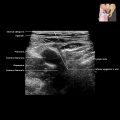KEY FACTS
Terminology
- •
Bronchopulmonary tissue that does not connect to tracheobronchial tree or pulmonary arteries
Imaging
- •
Homogeneously echogenic lesion adjacent to diaphragm
- ○
Typically triangular and well defined but can fill hemithorax and be difficult to differentiate from compressed lung
- ○
- •
Color Doppler key: Prominent feeding vessel from aorta
- •
85-90% in chest; 90% left sided
- •
10-15% subdiaphragmatic
- ○
Stomach is displaced anteriorly by echogenic mass
- ○
Separate from adrenal gland
- ○
Has prominent feeding vessel from aorta just like those in chest
- ○
- •
Unilateral pleural effusion (same side as BPS) in 6-10%
- ○
May cause tension hydrothorax shifting heart and compressing mediastinal structures
- ○
Top Differential Diagnoses
- •
Congenital pulmonary airway malformation (CPAM)
- ○
Microcystic (echogenic) CPAM has similar appearance
- ○
Vascular supply from pulmonary arteries, not aorta
- ○
- •
Neuroblastoma: Most common differential consideration for subdiaphragmatic sequestration
- ○
More often on right
- ○
Often cystic with no feeding vessel
- ○
Clinical Issues
- •
10-20% of fetal lung masses
- •
Associated anomalies reported in up to 50%
- ○
Most commonly associated with congenital diaphragmatic hernia but is often missed
- ○
- •
Excellent prognosis when isolated finding
Scanning Tips
- •
Use color Doppler on every chest mass looking for blood supply
 is from the aorta
is from the aorta  . It is sequestered from the surrounding lung, and there is no communication with the tracheobronchial tree.
. It is sequestered from the surrounding lung, and there is no communication with the tracheobronchial tree.
 . A large feeding vessel is seen coming from the aorta
. A large feeding vessel is seen coming from the aorta  . A tracing from this vessel (below) shows the classic aortic waveform with a sharp, rapid upstroke.
. A tracing from this vessel (below) shows the classic aortic waveform with a sharp, rapid upstroke.










